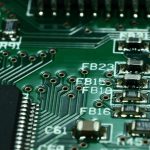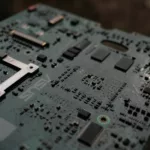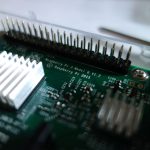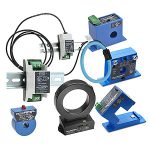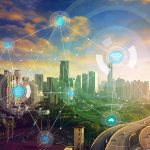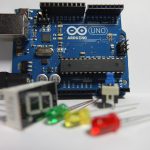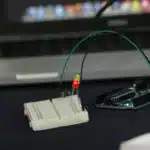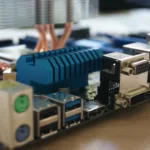
Introduction
The modern technological world is rapidly moving towards an interconnected ecosystem of devices. At the heart of this transition is the Internet of Things (IoT), a vast network of sensors, appliances, vehicles, and more, all communicating and sharing data. But what’s amplifying the potential of IoT? The answer is Artificial Intelligence (AI) and Machine Learning (ML)–paving the way for a future where devices are connected and intelligent. A cornerstone of this intelligence is the capability for predictive automation. This article clarifies the concept of integrating AI and Machine learning in IoT landscape and how this convergence results in predictive automation, revolutionising industries and our daily lives.
IoT, Artificial Intelligence, and Machine Learning: A Brief Introduction
IoT refers to the interconnected nature of devices and systems communicating with each other over the internet. These devices range from simple sensors to smartphones to high-end machines.
AI is a broad field aiming to create machines capable of mimicking human intelligence. This simulation process involves acquiring crucial information and tasks, such as learning, reasoning, self-correction, and voice and image recognition.
ML, a subset of AI, focuses on using statistical techniques to enable machines to boost their performance on a particular task over time, using data. Machine learning involves using statistical methods instead of being explicitly programmed, advancing various sectors, including healthcare and entertainment.
The Convergence of AI/ML and IoT: The Significance of Symbiotic Relationship
The convergence of AI/ML and the IoT is reshaping the landscape of technology and business, leading to the rise of the term “AIoT” (Artificial Intelligence of Things). This union holds a symbiotic relationship where AI amplifies the capabilities of IoT, and IoT brings real-world data to AI. IoT devices constantly generate data, feeding AI and ML to learn, predict, and act. Furthermore, AI provides the intelligence to make IoT devices smarter. With AI and ML, IoT devices can collect data and make sense of it. This capability allows for quicker and more informed decisions, leading to better outcomes.
Predictive Automation: A Deeper Dive
Predictive automation involves using data-driven predictions to automate specific tasks. For example, an AI-powered thermostat can learn a household’s routine and adjust the temperature automatically, optimising comfort while saving energy. Predictive automation in IoT refers to using predictive analytics, machine learning, and other advanced algorithms to enable automated responses and actions based on the anticipated outcomes derived from the data. This approach predicts future outcomes (from predictive analytics) with the capability to act upon these predictions automatically.
Benefits of Predictive Automation in IoT
Predictive automation brings a myriad of benefits to IoT ecosystems. Some of these benefits include:
- Efficiency and Cost Savings: Predictive automation benefits multiple enterprises by predicting when a device or system might fail. This allows businesses to perform maintenance only when necessary, reducing costs.
- Enhanced User Experience: Devices anticipating user needs can provide more intuitive and seamless experiences.
- Sustainability: Predictive automation can lead to more sustainable practices, such as optimising energy usage or reducing waste in manufacturing processes.
How Predictive Automation Works?
Predictive automation works in a straightforward sequential manner and includes the following mechanisms.
- Data Collection: IoT devices gather real-time data, such as temperature readings from a thermostat, vibration levels from a factory machine, or heart rate data from a wearable device.
- Data Analysis: The collected data is sent to a central system or cloud where ML algorithms analyse it. Over time, the algorithms improve at making predictions based on historical and real-time data.
- Decision Making: Once the ML models make a prediction, AI algorithms can decide the best course of action. For example, if a machine is predicted to fail in the next week, AI can decide whether to shut it down immediately or schedule maintenance.
- Action: Finally, IoT devices can then take automated actions based on decisions. For instance, adjusting the temperature, ordering replacement parts, or alerting a human operator.
Use Cases of Predictive Automation in Various Industries
Predictive automation has the potential to revolutionise various sectors. Some of the use cases include:
- Healthcare – Wearable devices can predict potential health issues and automatically notify healthcare professionals, improving patient health and care.
- Smart Homes – Predictive automation is significant in smart homes that can adjust heating or cooling based on the predicted weather and learned user preferences–resulting in energy savings.
- Manufacturing – Predictive maintenance is pivotal in manufacturing and can forecast when equipment will fail and automate the process of scheduling repairs, thereby reducing downtime.
- Transportation – Predictive maintenance can inform fleet managers when a vehicle will likely to break down, preventing costly downtimes.
- Energy – Smart grids can predict energy usage patterns and adjust distribution in real time, leading to more efficient energy consumption.
Implementing AI and ML in IoT: The Poised Challenges
Implementing AI and ML in IoT brings a new paradigm to the world of interconnected devices; however, it also comes with several challenges. Some prominent concerns include data privacy and security, scalability, latency, power consumption, complexity, costs, and dependency on data quality.
Bottom Lines
The fusion of AI, ML, and IoT paints a future where devices can communicate, predict, learn, and act autonomously. This predictive automation revolutionises industries, enhances user experiences, and ushers in a new era of robust efficiency. Technology’s responsible and ethical use is essential to address the poised challenges –promising an exciting future for the interconnected world.






